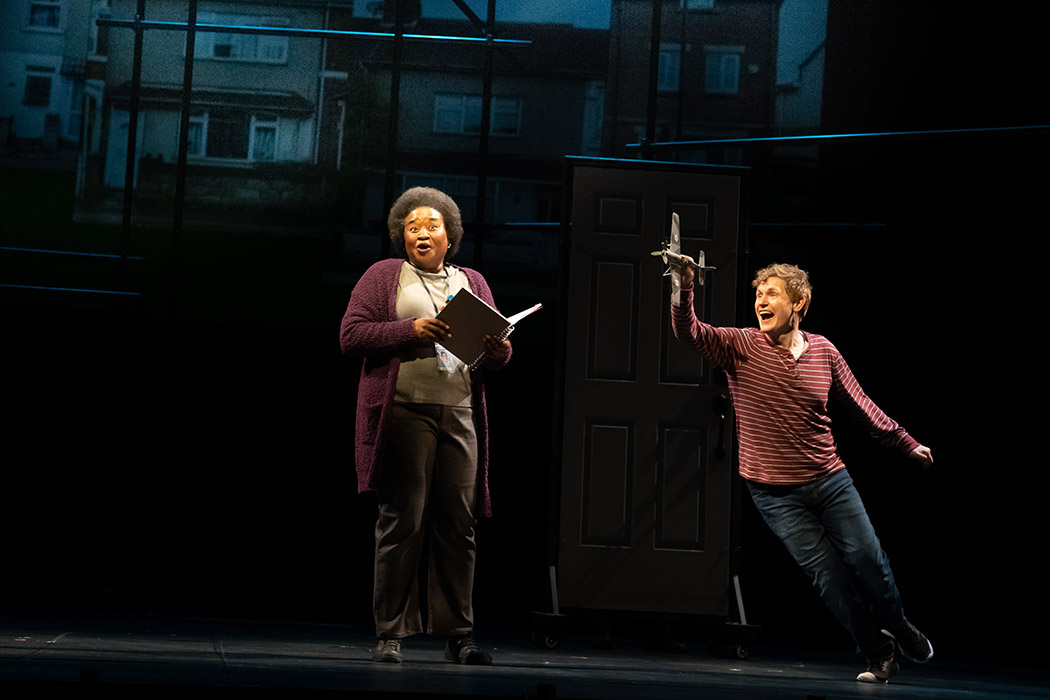For an audience, a theatrical production is a snapshot in time, its effect influenced in both large and small degrees by the current environment of society and culture. Had the Clarence Brown Theatre produced The Curious Incident of the Dog in the Night-Time, say, three years ago in pre-Covid times, it may have felt quite different to audiences.
The Simon Stephens play, based on the 2003 Mark Haddon novel, premiered in London before having a notable 2-year Broadway run, winning the 2015 Tony Award for Best Play. As if unconsciously acknowledging the discombobulating effects of Covid precautions, this marvelously intriguing production directed by John Sipes that opened on Friday evening at Clarence Brown Theatre, finds itself both sweetly sympathetic—and empathetic—to feelings of isolation, helplessness, panic, and disorientation.
Those are some of the feelings of 15-year old Christopher Boone, who lives with his father in Swindon, a sizable town west of London. Christopher suffers from an unnamed autistic condition that seems to be something akin to Asperger’s Syndrome. He is gifted intellectually, particularly in math and in the examination of facts and data, but is unable to deal with physical contact from others—and is painfully confused by conversations that involve the illogical indirectness of clichés and metaphors. In general, he lives imprisoned in an array of daily routines, likes, and dislikes from which there is no escape.
As the play begins, Christopher has discovered the body of the next-door neighbor’s dog that has been killed with a pitchfork. The dog’s owner, Mrs. Shears, encounters Christopher at the body and blames him for the murder. Christopher, though, obsessively latches onto the event as a serious mystery that must be solved through examination of clues and deduction based on facts. This sets up a journey through the play’s narrative arc, and also, through the distorted perception of the world as Christopher experiences it. Of course, as Sherlock Holmes might offer—every mystery may be more, or less, than it seems.
With Haddon’s novel set in the first person, Stephens employs an interesting Act I narrative device to simulate that point of view. He has Christopher’s special needs teacher, Siobhan (the excellent Shinnerrie Jackson), read from a notebook in which the boy has recorded events and thoughts, a process that simultaneously acts as exposition and allows the audience to understand Christopher’s often manic and eccentric delivery.
The authors have also injected the issue of how a problem child affects the societal and relationship health of the parents, laying out motivations and actions, but in this case, leaving hard judgements on the results to the audience. In other words, walk a mile in another person’s shoes before deciding right and wrong.
Clearly, Christopher is a dream role for an actor able to sculpt a believable and sympathetic character out of traits and motivations he can never really share, and do so with nuance and sensitivity. Those characteristics were most certainly delivered in spades by Jason Edward Cook as Christopher. Portraying such an emotionally challenged character requires walking that thin line between too much and not enough, while keeping the audience intrigued and sympathetic. His unexpected curtain call epilogue to the play, which I will leave un-described for audiences to discover, caps off this performance tour de force.
Cook, previously seen by CBT audiences as Peter in Peter and the Starcatcher, was joined by a marvelous ensemble cast of familiar CBT actors, some of them from the UT Theatre Department faculty. David Brian Alley was Christopher’s tormented father, Ed, painting his role with a lot of heated emotion. Katie Cunningham was Christopher’s mother, Judy, who makes a wonderful character arc from a two-dimensional memory to a flesh and blood example of a caring mother. Carol Mayo Jenkins was the sympathetic and earnest neighbor to Christopher, Mrs. Alexander. Completing the ensemble, and taking multiple roles, were Jed Diamond, Nancy Duckles, Brady Moldrup, Michael Najman, and Christine Sage. Kudos, too, to Philip Thomson credited as Dialect Coach for helping the cast with truly believable British voices.
Sipes and his design team took a minimalist, but engaging, look and feel of metal piping in rectangular patterns and added depth to that landscape via projections. Those projections varied from telegraphing a scene’s locale to abstract suggestions of Christopher’s mental and physical experience. Small set pieces, such as doors, tables, and steps, glide on and off the stage, powered by ensemble members. In some ways, though, it often felt as if the stage area was perhaps too roomy with character entrances and exits covering more space and time than was comfortable for a scene’s rhythm. Scenic design was by Christopher Pickart; immersive lighting by Kenton Yeager; character-revealing costume design by Kyle Schellinger; supportively layered music and sound design by Joe Payne; and projection designs, heavily relied upon here for both abstraction and realistic suggestion, by Tate Thompson.
Perhaps as survivors amid Covid and its societal upheaval, we have more in common with Christopher Boone than we might realize—and perhaps that is the lesson that Sipes and cast want us to walk away with. We encounter disorienting situations on a daily basis that seem to defy reason and truth. Will a cute puppy like the one Christopher is given in the final scene make everything better? “Will everything be all right,” as Christopher is told by his parents? Each theatre-goer will have to answer that one for themselves.








